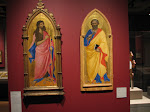
Hi All, I guess I am not grasping this blog experience the way I should – I am going to give this one more try. I visited the Yale Center for British Art, and although all of the artwork had a story to tell, I found the artwork by Henry Wallis (1830-1916) and Augustus Leopold Egg (1816-1863) extremely interesting. I also chose William Quiller Orchardson’s The Story of Life interesting.Wallis’ The Death of Chatterton, an oil on panel ca. 1856 displays Thomas Chatterton. Chatterton was an author and poet and accomplished a lot in his young life, however, much of Chatterton’s work was forged. Once this forgery was exposed Chatterton was not able to face the shame and disgrace, so he decided to take his own life, before it could even begin, at the tender age of 17. Chatterton was found holding a half filled vile of arsenic with his forged work torn and scattered about the floor. This is a small painting similar to the larger painting on display at the Royal AcademyEgg’s paintings, The Life of Buckingham and The Death of Buckingham took two years to finish because Egg wanted to make certain that every detail was captured. The Life of Buckingham displays the Duke of Buckingham entertaining and having a good time. Buckingham was known for his love of entertaining and living a life of luxury and elegance, contrary to the quiet and simple life that was expected. The rich colors are exquisite – Buckingham is a handsome man seated at the center of the table wearing fine apparel the white shirt sleeves shows pleated details and he is also wearing a jeweled neckpiece. I believe he is wearing a wig because I can’t imagine his hair being that long and perfectly curled and coiffed. There is a woman dancing on the table and men and women are intermingling, and these women are believed to be mistresses. All of the men and women seated at the table appear to be dressed in fine apparel. The room appears to be exquisitely furnished; the chairs are in rich reds, and golden mirrors are designed throughout the room. This clearly shows that Buckingham had good taste and enjoyed the finer things of life.Egg’s The Death of Buckingham depicts the opposite of the life that Buckingham lived. Egg wanted to show how one’s life could end if they didn’t live a quite life and lacked morality. Egg shows Buckingham dead on a dirty mattress in a seedy hotel impoverished and alone. Buckingham’s face is as white as a sheet, and unlike the handsome entertaining host, Buckingham appears old and haggard. You would never think the man depicted in this painting is the same handsome man in the next painting. The bed dressing is dirty, torn and ragged, and the room looks dismal, old and unkempt. There is a plate of food lying on the floor unlike the table settings, candles, luxury and elegance Buckingham was used to while he lived.I also found William Quiller Orchardson, 1832-1920, oil on canvas 1866, The Story of Life fascinating, and ironically, the opposite of two of the other painting which depicted death. Six young girls dressed modestly in white or bright colors symbolic of innocence and purity listen intently as an older nun dressed in habit filled with wisdom and dedicated to morality and integrity takes the time to teach these young women about life. Each young woman listens and is engaged and receptive as the nun explains about how one should live and what is to be expected. The girls appear to be in thought or maybe even imagining what is in store for each of their lives. One girl has a book maybe even the Proverbs open on her lap. The room is sparsely furnished, and may even be a gathering place because each of the women appears comfortable and well acquainted with one another.I would consider the paintings expressive art, and the thesis or points displayed were life, morality, and death. Overall I had a great experience, I only brought my camera and writing material in to the museum, the atmosphere was friendly, and there were many others in attendance, especially groups of people touring.
11:34:00 AM
by ad


Okay Angela... I'm happy to see this post... you are on your way..
ReplyDeleteThe editor that you write into on the blog works like word... you can paste a Word document into the editor box too... A good thing to do is to place photos into your text where appropriate using the small picture icon in the editor box along the top.
One thing to do would be to write about your chosen painting by placing it in an art historical context... that is, what movement is the piece identified with and why?
Here is a good introduction to Wallis in Wikipedia... http://en.wikipedia.org/wiki/Henry_Wallis
Notice he is considered to be a Pre-Raphealite... What does that mean? How does his piece show that? The Wikipedia arcticle refers to our young poet who took his life as a "Romantic Hero" Whay is that?
Good start... use regular pucntuation and paragraph structure and try to put your pictures in witht he text...